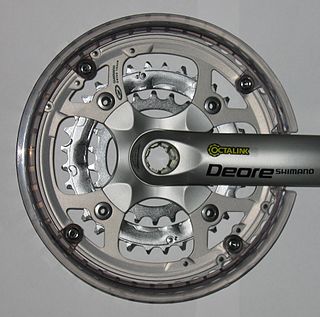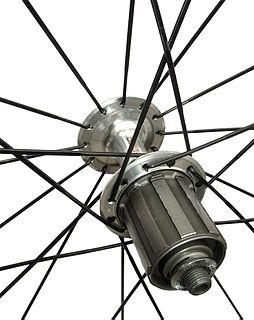
Derailleur gears are a variable-ratio transmission system commonly used on bicycles, consisting of a chain, multiple sprockets of different sizes, and a mechanism to move the chain from one sprocket to another. Although referred to as gears in the bike world, these bicycle gears are technically sprockets since they drive or are driven by a chain, and are not driven by one another.

A hub gear, internal-gear hub,, internally geared hub or just gear hub is a gear ratio changing system commonly used on bicycles that is implemented with planetary or epicyclic gears. The gears and lubricants are sealed within the shell of the hub gear, in contrast with derailleur gears where the gears and mechanism are exposed to the elements. Changing the gear ratio was traditionally accomplished by a shift lever connected to the hub with a Bowden cable, and twist-grip style shifters have become common.
Shimano, Inc. is a Japanese multinational manufacturer of cycling components, fishing tackle and rowing equipment. It produced golf supplies until 2005 and snowboarding gear until 2008. Headquartered in Sakai, Japan, the company has 32 consolidated subsidiaries and 11 unconsolidated subsidiaries. Shimano's primary manufacturing plants are in Kunshan, China; Malaysia; and Singapore.

The crankset or chainset, is the component of a bicycle drivetrain that converts the reciprocating motion of the rider's legs into rotational motion used to drive the chain or belt, which in turn drives the rear wheel. It consists of one or more sprockets, also called chainrings or chainwheels attached to the cranks, arms, or crankarms to which the pedals attach. It is connected to the rider by the pedals, to the bicycle frame by the bottom bracket, and to the rear sprocket, cassette or freewheel via the chain.

A bicycle chain is a roller chain that transfers power from the pedals to the drive-wheel of a bicycle, thus propelling it. Most bicycle chains are made from plain carbon or alloy steel, but some are nickel-plated to prevent rust, or simply for aesthetics.

A touring bicycle is a bicycle designed or modified to handle bicycle touring. To make the bikes sufficiently robust, comfortable and capable of carrying heavy loads, special features may include a long wheelbase, frame materials that favor flexibility over rigidity, heavy duty wheels, and multiple mounting points.
A groupset or gruppo is a bicycle component manufacturer's organized collection of mechanical parts. It generally refers to all of the components that make up a bicycle excluding the bicycle frame, fork, stem, wheels, tires, and rider contact points, such as the saddle and handlebars.

In mechanical or automotive engineering, a freewheel or overrunning clutch is a device in a transmission that disengages the driveshaft from the driven shaft when the driven shaft rotates faster than the driveshaft. An overdrive is sometimes mistakenly called a freewheel, but is otherwise unrelated.

Sturmey-Archer is a manufacturing company originally from Nottingham, England. It primarily produces bicycle hub gears, brakes and a great many other sundry bicycle components, most prominently during their heyday as a subsidiary of the Raleigh Bicycle Company. In the past, it also manufactured motorcycle hubs, gearboxes and engines.

A single-speed bicycle is a type of bicycle with a single gear ratio. These bicycles are without derailleur gears, hub gearing or other methods for varying the gear ratio of the bicycle.
SunTour (Maeda) was the most important Japanese manufacturer of bicycle components based in Osaka until 1988, when Sakae Ringyo Company, a major Japanese maker of aluminum parts, particularly cranks and seat posts, bought what was left of the bankrupt SunTour, and the combined companies are now known as SR-SunTour. SunTour reached a zenith of sales and commercial success from the late 1970s to the mid-1980s. Its products range from suspension forks to derailleurs.

On a bicycle, the cogset or cluster is the set of multiple sprockets that attaches to the hub on the rear wheel. A cogset works with a rear derailleur to provide multiple gear ratios to the rider. Cogsets come in two varieties, freewheels or cassettes, of which cassettes are a newer development. Although cassettes and freewheels perform the same function and look almost the same when installed, they have important mechanical differences and are not interchangeable.

A freehub is a type of bicycle hub that incorporates a ratcheting mechanism.

The Rohloff Speedhub is an epicyclic internal hub gear for bicycles, developed and patented by Rohloff AG. It has been manufactured and marketed by that company since 1998. The Speedhub 500/14 has 14 equally spaced sequential non-overlapping gear ratios operated by a single twistgrip. The overall gear range is 526%, meaning the highest gear is 5.26 times as high as the lowest gear. Individual gear shifts when shifting up give an increase of about 13.6%.

Bicycle gearing is the aspect of a bicycle drivetrain that determines the relation between the cadence, the rate at which the rider pedals, and the rate at which the drive wheel turns.

Flip-flop hubs, also called double-sided hubs, are rear bicycle hubs that are threaded to accept fixed cogs and/or freewheels on both sides.
Splines are ridges or teeth on a drive shaft that mesh with grooves in a mating piece and transfer torque to it, maintaining the angular correspondence between them.

An electronic gear-shifting system is a method of changing gears on a bicycle, which enables riders to shift with electronic switches instead of using conventional control levers and mechanical cables. The switches are connected by wire or wirelessly to a battery pack and to a small electric motor that drives the derailleur, switching the chain from cog to cog. An electronic system can switch gears faster, and because the system does not use Bowden cables and can calibrate itself, it may require less maintenance.

Bicycle drivetrain systems are used to transmit power on bicycles, tricycles, quadracycles, unicycles, or other human-powered vehicles from the riders to the drive wheels. Most also include some type of a mechanism to convert speed and torque via gear ratios.

















